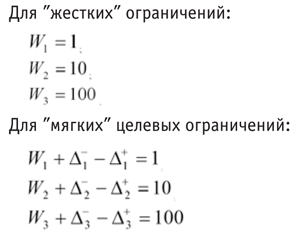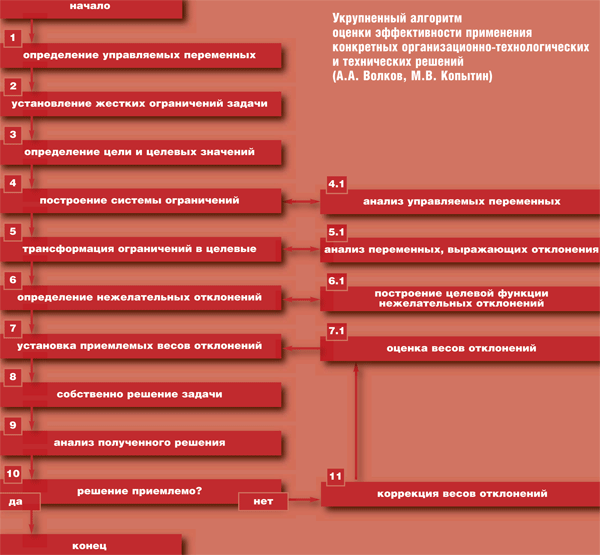
Technical and economic assessment of solutions of the “Intelligent Building” class in the reconstruction of buildings and structures.

Technical and economic assessment of the effectiveness of the application of specific organizational, technological and technical solutions is based on a multi-criteria analysis of various factors. To solve this problem, two methods have been adapted: target programming and the analytical hierarchy process.
In the first case, the selected goals are presented in the tasks as variable constraints.
This is a method for assessing organizational, technological and technical solutions, practically implemented on the basis of linear models, built on the basis of the use of iterative procedures, making it possible to study alternative solutions and select the best of them.
The use of the second method – analytical hierarchies – is based on the construction of a model of subjective evaluation of alternatives. In this case, it is necessary to assign assessments to each of the alternatives for each of the criteria used and the weights of the criteria reflecting their relative importance. For the final decision and selection of the best alternative, weighted average assessments are calculated for each of them. To assign assessments of alternatives and their weights, the analytical hierarchies method is used, which is a well-structured approach to solving such problems based on the use of pairwise comparison of alternatives and weights.
Fig. 1 shows a general algorithm for assessing the effectiveness of using specific organizational, technological and technical solutions as part of modern building management systems during the reconstruction of operating facilities based on the classical sequence of target programming steps.
It should be borne in mind that the peculiarity of target programming is the impossibility of comparing different solution alternatives based on the obtained values of the target function, since the weights of deviations in the target function change from iteration to iteration. Thus, comparing the values of the target functions does not make sense, since they express different requirements. In this case, the actual alternative solutions (the essence is the values of the controlled variables) are compared, and not the values of the target functions.
Within the framework of the presented algorithm, the target constraints show how accurately a specific solution ensures the achievement of the set goal. The differences between the so-called “soft” target constraints and the “hard” ones within the framework of the presented algorithm can be illustrated by their mathematical notation.
In this case, . The introduced variables determine the spread (or deviation) of each of the constraints from their target value, determined by the right-hand side. The variables determine the underfulfillment of the target requirement, and the variables determine the overfulfillment of the target requirement.
In practice, the number of “soft” and “hard” target constraints is not standardized in any way and is determined in each specific case by the specifics of the reconstruction project.
The target function within the framework of this algorithm can be generally expressed as follows:
where:
– the right side of the -th target constraint, and – the weights of the -th variable, expressing the desirability of negative and positive deviations from the specified goals in the sense of underfulfillment or overfulfillment of the requirements contained in them.
When using the second method – analytical hierarchies, based on the construction of a model of subjective assessment of alternatives, the following adapted scale of assessment of alternatives is used to solve most of the problems in the dissertation:
1. Alternatives are recognized as equivalent.
2. Between equivalence and slight preference.
3. Slight preference.
4. Between moderate and medium preference.
5. Medium preference.
6. Between medium and strong preference.
7. Strong preference.
8. Between strong and full preference.
9. Full preference.
Based on the analysis of data obtained as a result of applying the solutions substantiated above, it is advisable to consider the following set of classes of acceptable organizational, technological and technical solutions used in the process of reconstruction of operated facilities in the context of the subject of our conversation:
– Class I – bringing the operational, functional and other characteristics of a building or structure into line with the design, structures, engineering and other equipment and systems;
– Class II – bringing the operational, functional and other characteristics of a building or structure into line with current requirements, structures, engineering and other equipment and systems;
– Class III – minor changes in the operational, functional and other characteristics of a building or structure, structures, engineering and other equipment and systems;
– Class IV – significant changes in the operational, functional and other characteristics of a building or structure, structures, engineering and other equipment and systems;
– Class V – changes in the vast majority of operational, functional and other characteristics of a building or structure, structures, engineering and other equipment and systems.
Classes I and II correspond to the so-called minor reconstruction, and IV and V – to a complete (radical) reconstruction of objects in the sense of the accepted terminology. Class III is borderline and can correspond to both concepts to one degree or another.
Technical and economic assessment of the effectiveness of the use of specific organizational, technological and technical solutions is based on a multi-criteria analysis of various factors.
To solve this problem, two methods have been adapted: target programming and the analytical hierarchy process.
In the first case, the selected goals are presented in the tasks as variable constraints.
This is a method for assessing organizational, technological and technical solutions, practically implemented on the basis of linear models, built on the basis of the use of iterative procedures that make it possible to explore alternative solutions and select the best of them.
The use of the second method – analytical hierarchies – is based on the construction of a model of subjective evaluation of alternatives.
In this case, it is necessary to assign assessments to each of the alternatives for each of the criteria used and the weights of the criteria reflecting their relative importance.
For the final decision and selection of the best alternative, weighted average assessments are calculated for each of them.
To assign assessments of alternatives and their weights, the analytical hierarchy process method is used, which is a well-structured approach to solving such problems based on the use of pairwise comparison of alternatives and weights.
Figure 1 shows a generalized algorithm for assessing the effectiveness of using specific organizational, technological and technical solutions as part of modern building management systems during the reconstruction of operating facilities based on the classical sequence of target programming steps.
It should be borne in mind that the peculiarity of target programming is the impossibility of comparing different solution alternatives based on the obtained values of the objective function, since the weights of deviations in the objective function change from iteration to iteration.
Thus, comparing the values of the objective functions does not make sense, since they express different requirements.
In this case, the actual alternative solutions are compared (the essence is the values of the controlled variables), and not the values of the objective functions.
Within the framework of the presented algorithm, target constraints show how accurately a specific solution ensures the achievement of the set goal.
The differences between the so-called “soft” target constraints and the “hard” ones within the framework of the presented algorithm can be illustrated by their mathematical notation.

In this case, . The introduced variables determine the spread (or deviation) of each of the constraints from their target value, determined by the right-hand side.
The variables determine the underfulfillment of the target requirement, and the variables determine the overfulfillment of the target requirement.
In practice, the number of “soft” and “hard” target constraints is not standardized in any way and is determined in each specific case by the specifics of the reconstruction project.
The target function within the framework of this algorithm can be generally expressed as follows:
where:

is the right-hand side of the -th target constraint, and are the weights of the -th variable, expressing the desirability of negative and positive deviations from the specified goals in the sense of underfulfillment or overfulfillment of the requirements contained in them.
When using the second method — analytical hierarchies, based on the construction of a model of subjective assessment of alternatives, the following adapted scale of assessment of alternatives is used to solve most of the problems in the dissertation:
1. Alternatives are considered to be of equal value.
2. Between equivalence and slight preference.
3. Slight preference.
4. Between moderate and medium preference.
5. Medium preference.
6. Between medium and strong preference.
7. Strong preference.
8. Between strong and full preference.
9. Full preference.
Based on the analysis of data obtained as a result of applying the solutions substantiated above, it is advisable to consider the following set of classes of acceptable organizational, technological and technical solutions used in the process of reconstruction of operated facilities in the context of the subject of our conversation:
– Class I – bringing the operational, functional and other characteristics of a building or structure into line with the design, structures, engineering and other equipment and systems;
– Class II – bringing the operational, functional and other characteristics of a building or structure into line with current requirements, structures, engineering and other equipment and systems;
– Class III – minor changes in the operational, functional and other characteristics of a building or structure, structures, engineering and other equipment and systems;
– Class IV – significant changes in the operational, functional and other characteristics of a building or structure, structures, engineering and other equipment and systems;
– Class V – changes in the overwhelming majority of operational, functional and other characteristics of a building or structure, structures, engineering and other equipment and systems.

Classes I and II correspond to the so-called minor reconstruction, and IV and V – to a complete (radical) reconstruction of objects in in the sense of the accepted terminology. Class III is borderline and can correspond to both concepts to one degree or another.

Добавить комментарий